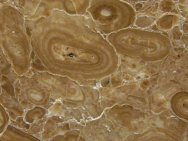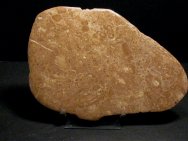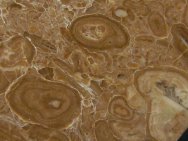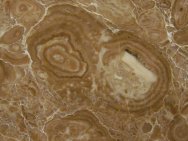|
Girvanella
Form Genera
(hand-polished)
Geological
Time: Paleocene
Size (25.4
mm = 1 inch): 240 mm across widest diagonal
Fossil
Site: Flagstaff Limestone, Thistle, Utah
Code: DS1435
Price:
Sold
|  These
Paleocene stromatolites exemplify the diminished status of stromatolite-forming
bacteria during the Phanerozoic Eon. The huge microbial mats building
stromatolitic reefs were long gone by the Cambrian, relegating
the prokaryotic builders to the bottom of an ever more complex
food chain. Oxygenation of air and These
Paleocene stromatolites exemplify the diminished status of stromatolite-forming
bacteria during the Phanerozoic Eon. The huge microbial mats building
stromatolitic reefs were long gone by the Cambrian, relegating
the prokaryotic builders to the bottom of an ever more complex
food chain. Oxygenation of air and  water
prior to, and continuing in the Cambrian also made for a much
more hostile environment for the bacteria. These stromatolites
from the early Cenozoic era exhibit a small Girvanella form comprising
irregular, unsymmetrical spherical nodule sometimes called algal
balls. In this case the nodules are generally small and many.
Girvanella is more commonly found in Cambrian and younger stromatolites,
when bacterial colonies were subject to predation, such as from
various members of Domain Eukarya that dominated marine reef systems
after the Cambrian Explosion. water
prior to, and continuing in the Cambrian also made for a much
more hostile environment for the bacteria. These stromatolites
from the early Cenozoic era exhibit a small Girvanella form comprising
irregular, unsymmetrical spherical nodule sometimes called algal
balls. In this case the nodules are generally small and many.
Girvanella is more commonly found in Cambrian and younger stromatolites,
when bacterial colonies were subject to predation, such as from
various members of Domain Eukarya that dominated marine reef systems
after the Cambrian Explosion.
|
|





